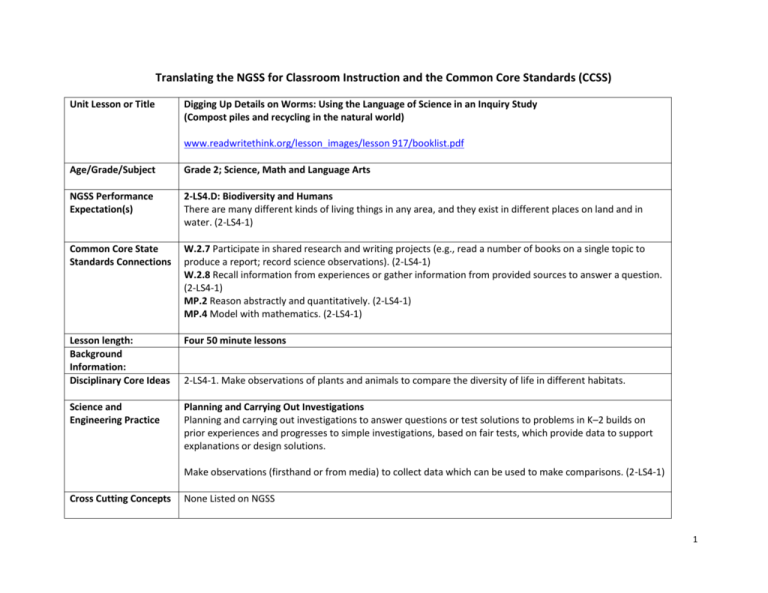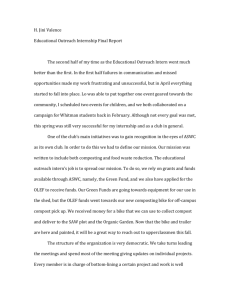Grade 2 - Digging Up Details on Worms
advertisement

Translating the NGSS for Classroom Instruction and the Common Core Standards (CCSS) Unit Lesson or Title Digging Up Details on Worms: Using the Language of Science in an Inquiry Study (Compost piles and recycling in the natural world) www.readwritethink.org/lesson_images/lesson 917/booklist.pdf Age/Grade/Subject Grade 2; Science, Math and Language Arts NGSS Performance Expectation(s) 2-LS4.D: Biodiversity and Humans There are many different kinds of living things in any area, and they exist in different places on land and in water. (2-LS4-1) Common Core State Standards Connections W.2.7 Participate in shared research and writing projects (e.g., read a number of books on a single topic to produce a report; record science observations). (2-LS4-1) W.2.8 Recall information from experiences or gather information from provided sources to answer a question. (2-LS4-1) MP.2 Reason abstractly and quantitatively. (2-LS4-1) MP.4 Model with mathematics. (2-LS4-1) Lesson length: Background Information: Disciplinary Core Ideas Four 50 minute lessons Science and Engineering Practice Planning and Carrying Out Investigations Planning and carrying out investigations to answer questions or test solutions to problems in K–2 builds on prior experiences and progresses to simple investigations, based on fair tests, which provide data to support explanations or design solutions. 2-LS4-1. Make observations of plants and animals to compare the diversity of life in different habitats. Make observations (firsthand or from media) to collect data which can be used to make comparisons. (2-LS4-1) Cross Cutting Concepts None Listed on NGSS 1 5E Stage Science/Engineering Practice or Crosscutting What the Teacher Does… What the Students Do…. Engage Planning and Carrying Out Investigations Planning and carrying out investigations to answer questions or test solutions to problems in K–2 builds on prior experiences…(2-LS2-1) Ask students to share information that they know about worms. Encourage students to talk about their observations, experiences, and feelings (to explain what they know), and to explain why they shared the information (to explain how they know). Students can also add any questions they may have about worms. Introduce the word “hypothesis” Introduce a fiction book on worms from the booklist to the class by asking students to make observations based on the cover of the book. Teacher will read the book of his or her choice from the list. (Compost piles, recycling in natural world) Pass out the notebooks and explore the kinds of Students will write’ responses on the board, chart paper, or as part of a KWL chart. Students will record their own ideas about worms and the project in their notebooks. Recordings can include text and drawings. Explore Planning and carrying out investigations to answer Students will give prior knowledge of “hypothesis.” Students will make observations about the cover and their knowledge of worms; ask students to make a hypothesis on whether the book is a story of fact or fiction. If needed, review the differences between fact and fiction briefly at this point. Children record their hypothesis about whether What Are Students Learning? What is the Evidence of Learning? Prior experiences and observations to connect information to lives and vocabulary (meta-cognition) for word acquisition (vocab building). Examples on chart or blackboard. Building connections between prior knowledge and new knowledge through the senses (Using Gardner-learning styles and meta-cognition—to build schemas-Bruner): KWL chart and drawings. Participation in group discussion, illustrating 2 questions or test solutions to problems in K–2 builds on prior experiences and progresses to simple investigations, based on fair tests, which provide data to support explanations or design solutions. Make observations (firsthand or from media) to collect data which can be used to make comparisons. (2LS4-1) Explain Elaborate information that scientists record in such journals: observations, questions, reflections, findings, and so forth through discussion. Allow time at the end of the session for students to explore additional books from the booklist (http://www.readwriteth ink.org/lesson_images/le sson917/Booklist.pdf) the book is fact or fiction— prior to reading. Children record how they think worms help in recycling the natural world’s soil— prior to reading. assimilation of knowledge and schemas built in recordings. Explain that the class will create a worm habitat, which will be kept in the classroom, so that they can observe and learn more about worms. Explain how worms help recycle and enrich the soil. Explain that students will keep inquiry notebooks as they work on this project. Have children record findings Teacher will ask students to extend observations to landfills, compost piles in a garden. Children record their findings in their observation journals. Students integrate expert and go beyond given information to generate and improve their ideas as is evidenced by their hypothesis and results recorded in the journal through observation and critical extension. Students will talk among themselves about how the natural world recycles—as an extension advance students Participation in group discussion, illustrating assimilation of knowledge and extending knowledge to 3 Evaluate Extend: Invite the students to participate in Math and Science Centers based on the worms and their habitat. Ask students to review the list, and decide whether they support the class hypothesis about whether the book was fact or fiction. can create a compost pile at school or in class. Students will extend knowledge through center learning. generate new ideas. Extend: These activities also invite students to write in their inquiry notebooks.* Participation in class discussions. Engagement in the inquiry process (searching for and recording answers about worms). Printouts from the Animal Inquiry interactive. Level of detail in inquiry notebooks, including facts and observations. Grouping Strategies Whole group: cooperative grouping Peer grouping, Task assigned: compost versus habitat One-on-one for bridging the gap and struggling learners Center grouping: Math, Science or Reading Materials and Equipment Chart paper, board or KWL sheet, observation notebooks, soil, worms (can be dug up from schoolyard or bought from store), habitat, spray bottle, plants or grass, computers with internet access, Science Centers: flash light, magnifying glass, plastic spade, rulers with metric and inches, crayons, and extra pencils. Math Centers: Graph paper, kidney beans, Cheerios, and gummy worms, bean counters, math manipulative cubes. Description of Performance Tasks Note: The performance tasks should include 4 elements from the three dimensions from the NGSS – knowing and doing Supporting English Learners Reading or Writing Activity Listed in Learning and Instructional Sequence Story: Chart/ vocabulary words Creation of Class Recycle Book Support for Emerging learners Support for Expanding learners Support for Bridging learners Whole group Sentence construction Peer observations Persuasive poster/picture for around school Adult supervision and peer observations Supporting Struggling Learners Activity listed in Learning and Instructional Sequence Write the word or draw a picture for recycle on a sheet of chart paper Categorize recyclable materials create recycled sculptures Discuss differences and similarities in created sculptures Create a Recycled Treasure Support for Students who Need Minor Support Supports for Students who Need Intensive Support Adult supervision Adult supervision 5 Book: Supporting Advanced Learners Activity Listed in Learning and Instructional Sequence Extension for Advanced Students Under elaborate: Students will talk among themselves about how the natural world recycles—as an extension advance students can create a compost pile at school or in class. Build a compost pile at the school to learn even more about worms. When the pile has had time to mature, invite the students to dig with a large shovel and observe the animals living there. Ask the students to record their observations, using the observation form (http://www.readwritethink.org/lesson_images/lesson917/CompostPileO bservations.pdf) 6







